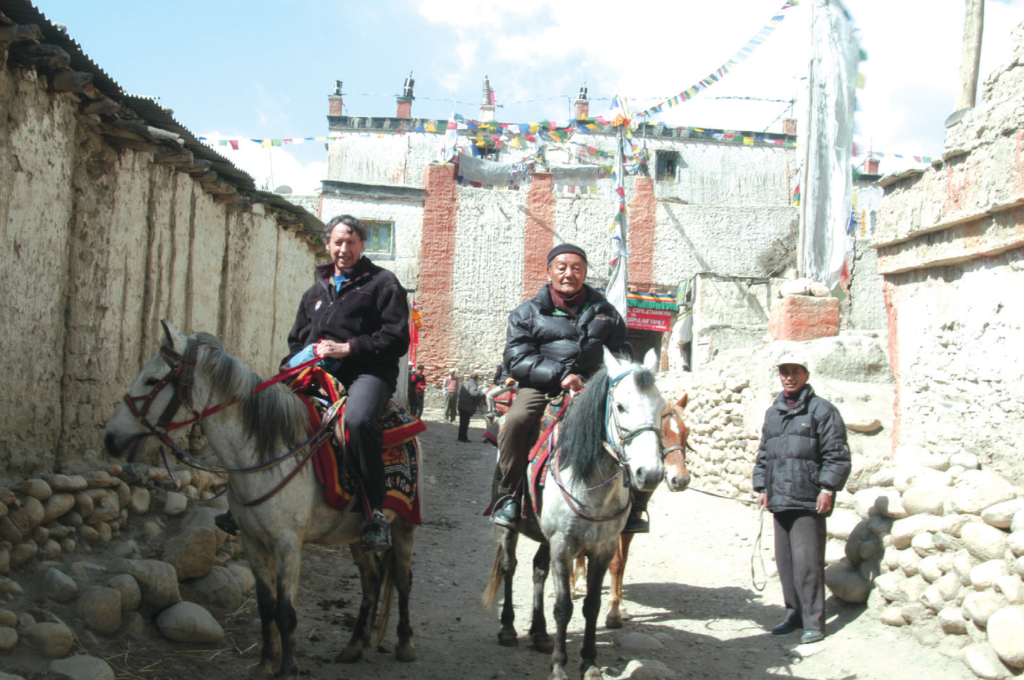
With Raja Jigme Bista, king of Mustang, in 2010 on LoMontang’s preferred method of transit.
Our progress in restoring the temples and monasteries of LoMontang was slow in the first years. Some bureaucrats in Kathmandu blocked and then delayed the permits we needed, and we had to keep a close eye on the money we put into local charities to make sure it didn’t end up in the wrong bank accounts.
Within a few years, though, we landed a great talent as project director—the world-renowned conservator John Sanday. His resume boasted historic cultural gems such as Angkor Wat in Cambodia, palaces in India and Kathmandu, and the Forbidden City in China.
As he would write later, though, the triumphs Sanday orchestrated in the LoMontang temples and monastery were “the most daunting, and rewarding, challenges of my professional career.”
Decaying beams and columns supporting Thubchen’s three-foot-thick earthen roof were replaced with some sixty timbers. All had to be cut, hoisted, and carried on foot – eight men to a log – over several miles and many days from a Tibet forest beyond the Chinese border. Raja Jigme Bista himself journeyed to that Tibetan village on horseback to arrange the deal. (He lost his official title as king in 2008 after Nepal abolished its monarchy and reintroduced a parliamentary form of government.) The replaced rafters were so decayed that, in Sanday’s judgment, the roof could have collapsed at the slightest provocation.
There was a lot of skepticism then. Communications were problematic, as cell phones didn’t function in Mustang. Then, too, well-meaning local folks were thinking too small, sending us skimpy budgets for patchwork ideas.
It took four years to make the buildings structurally sound, sealed off from wind and rain, and safe before efforts to restore the artwork could begin. “We were literally in the Middle Ages,” said Luigi Fieni, the talented Italian artist we recruited. He first came to LoMontang in 1998 when there was “no electricity, no means of communication, and no means of transportation.”
After a few more years, though, the historical significance of these paintings became clear. You could see more details beneath the dirt and grime. We were uncovering astonishing examples of ancient Tibetan Buddhist art. It was captivating, beyond belief. Everyone involved was astounded, excited.
The Independent newspaper reported in 2013 that the artwork might rank among the most valuable in the Himalaya, “the best-surviving examples of classical Tibetan monastic architecture of the Sakya-pa, one of four major schools of Tibetan Buddhism.” Our hope is Tibetan Buddhists and others in South Asia and around the world will be drawn to these venerable structures and the resplendent icons within.
The devastating earthquakes that shook Nepal, killing 9,000 in the spring of 2015, might have turned the restorations to rubble. But we were extremely fortunate. The first temblor, a 7.8-magnitude quake, separated wide portions of paintings in Thubchen from their wall. In Jampa, walls on the upper level were detached from the floor, and some sections of wall paintings on other levels either fell or were detached.
But repairs to structural damage at Thubchen and Jampa were completed in 2016. We expect to start and complete repairs to damaged artwork in Jampa this summer, and long-planned extension of the art in Thubchen as well. Finishing in 2017 is five years later than we’d aimed for a decade ago, but as I wrote last time, we really had no idea what timeline we were committing to twenty five years ago. What truly mattered, we never forgot, was trust: the king was willing to take a chance on us—and we, on him.
Sadly, Raja Jigme Dorje Palbar Bista will not to be with us when we celebrate. He passed away last month in Kathmandu at age 86. Hundreds paid their respects during the three days his body laid in state, including government ministers, senior politicians and religious and social leaders. One Nepali lawmaker, sitting with our foundation’s regional director Bruce Moore at the cremation ceremony, said that for those who knew him, the raja “earned our respect as a wise, just and caring king.”
Photo courtesy of the American Himalayan Foundation.

Leave a Reply